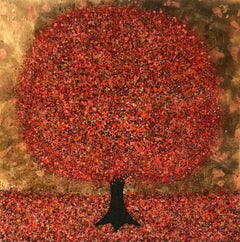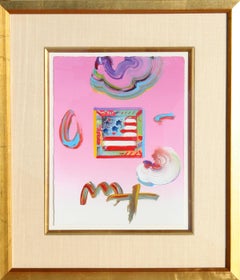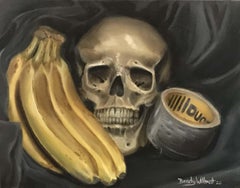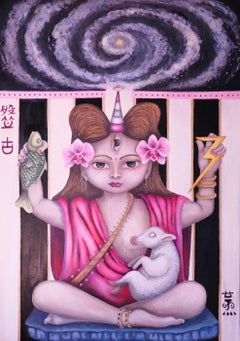Still-life Paintings
21st Century and Contemporary Pop Art Still-life Paintings
Canvas, Resin, Acrylic
1990s Surrealist Still-life Paintings
Canvas, Acrylic
Early 2000s Pop Art Still-life Paintings
Acrylic
2010s Pop Art Still-life Paintings
Canvas, Oil
2010s Surrealist Still-life Paintings
Canvas, Oil
2010s Surrealist Still-life Paintings
Canvas, Oil
2010s Surrealist Still-life Paintings
Oil
Early 2000s Surrealist Still-life Paintings
Canvas, Oil
2010s Surrealist Still-life Paintings
Oil, Panel
2010s Surrealist Still-life Paintings
Acrylic
Early 2000s Surrealist Still-life Paintings
Oil
21st Century and Contemporary Surrealist Still-life Paintings
Canvas, Oil
2010s Surrealist Still-life Paintings
Oil, Panel
2010s Pop Art Still-life Paintings
Varnish, Acrylic
1960s Pop Art Still-life Paintings
Canvas, Oil, Wood
2010s Pop Art Still-life Paintings
Acrylic, Panel
21st Century and Contemporary Surrealist Still-life Paintings
Wood Panel, Gouache
2010s Pop Art Still-life Paintings
Varnish, Acrylic, Panel
2010s Surrealist Still-life Paintings
Oil, Wood Panel
Artist Comments
Artist John Jaster renders an impressionistic still life in bright, cheerful colors. A teapot, a ceramic cup, a slice of lemon, a bowl of limes, and a vase of flowers, all set on a floral tablecloth...
21st Century and Contemporary Pop Art Still-life Paintings
Acrylic
2010s Pop Art Still-life Paintings
Varnish, Acrylic, Panel
Artist Comments
Artist John Jaster portrays a fresh display of red and green grapes with a ripe pomegranate placed in a glass bowl. Set above a patterned table cloth, the glass reflects light and vibrant hues of pink that surrounds it. Bunches of grapes nest in the cloth's loose crease reminiscent of tiny bird eggs. The dark background highlights the scene completing the composition.
About the Artist
Artist John Jaster paints in a style he describes as realistic impressions, capturing colorful views of his adventures across the Americas. "People always ask me how I get such deep brilliant colors," says John. "The answer is layers. Since acrylic paint dries mostly transparent, it requires multiple layers of paint to build up to a specific color. With the right lighting that depth of layering is like sunshine glistening through clear water." In college, John felt a pull towards computer science and pursued a career in software architecture. Although the two paths may seem unrelated, John says his work in software strongly influences his artwork in terms of distilling complex systems without losing the magic and wonder. Today, John works from a large home studio with a fireplace, lots of natural light, and jazz playing in the background. Since 2010, John’s paintings have been displayed in over 90 juried exhibitions and published in leading art magazines and books.
Words that describe this painting: grapes, glass, bowl, pomegranate, tablecloth, still life, fruits, cloth, pop, acrylicpaint, pop, still life, acrylic painting, pink
21st Century and Contemporary Pop Art Still-life Paintings
Acrylic
Early 2000s Pop Art Still-life Paintings
Canvas, Acrylic
Early 2000s Pop Art Still-life Paintings
Canvas, Oil
2010s Surrealist Still-life Paintings
Linen, Oil
21st Century and Contemporary Surrealist Still-life Paintings
Linen, Oil
2010s Surrealist Still-life Paintings
Linen, Oil
2010s Surrealist Still-life Paintings
Linen, Oil
2010s Surrealist Still-life Paintings
Linen, Oil
2010s Surrealist Still-life Paintings
Linen, Oil
Early 2000s Pop Art Still-life Paintings
Acrylic, Canvas
21st Century and Contemporary Pop Art Still-life Paintings
Found Objects, Oil, Plastic
2010s Surrealist Still-life Paintings
Oil, Wood Panel
Early 2000s Pop Art Still-life Paintings
Canvas, Oil
1960s Surrealist Still-life Paintings
Wood, Oil
2010s Surrealist Still-life Paintings
Linen, Oil
21st Century and Contemporary Pop Art Still-life Paintings
Canvas, Oil
2010s Surrealist Still-life Paintings
Linen, Oil
1990s Pop Art Still-life Paintings
Paper, Acrylic
2010s Pop Art Still-life Paintings
Wood, Mixed Media
21st Century and Contemporary Pop Art Still-life Paintings
Canvas, Acrylic
2010s Surrealist Still-life Paintings
Linen, Oil
2010s Surrealist Still-life Paintings
Oil, Linen
2010s Surrealist Still-life Paintings
Oil, Linen
2010s Surrealist Still-life Paintings
Oil, Linen
21st Century and Contemporary Pop Art Still-life Paintings
Canvas, Oil, Screen
1960s Surrealist Still-life Paintings
Canvas, Oil
2010s Surrealist Still-life Paintings
Archival Paper, Watercolor
2010s Surrealist Still-life Paintings
Oil, Linen
2010s Surrealist Still-life Paintings
Oil, Linen
2010s Surrealist Still-life Paintings
Oil, Linen
2010s Surrealist Still-life Paintings
Acrylic
1970s Pop Art Still-life Paintings
Silk, Paper
2010s Surrealist Still-life Paintings
Canvas, Oil
2010s Surrealist Still-life Paintings
Mixed Media
20th Century Surrealist Still-life Paintings
Acrylic
2010s Surrealist Still-life Paintings
Watercolor, Archival Paper
Late 20th Century Pop Art Still-life Paintings
Canvas, Acrylic
Shop Still-Life Paintings on 1stDibs
Still-life paintings work as part of the decor in nearly every type of space.
Still-life art, which includes work produced in media such as painting, photography, video and more, is a popular genre in Western art. However, the depiction of still life in color goes back to Ancient Egypt, where paintings on the interior walls of tombs portrayed the objects — such as food — that a person would take into the afterlife. Ancient Greek and Roman mosaics and pottery also often depicted food. Indeed, still-life paintings frequently feature food, flowers or man-made objects. By definition, still-life art represents anything that is considered inanimate.
During the Middle Ages, the still life genre was adapted by artists who illustrated religious manuscripts. A common theme of these paintings is the reminder that life is fleeting. This is especially true of vanitas, a kind of still life with roots in the Netherlands during the 17th century, which was built on themes such as death and decay and featured skulls and objects such as rotten fruit. In northern Europe during the 1600s, painters consulted botanical texts to accurately depict the flowers and plants that were the subject of their work.
Leonardo da Vinci’s penchant for observing phenomena in nature and filling notebooks with drawings and notes helped him improve as an artist of still-life paintings. Vincent van Gogh, an artist who made a couple of the most expensive paintings ever sold, carried out rich experiments with color over the course of painting hundreds of still lifes, and we can argue that Campbell’s Soup Cans (1961–62) by Andy Warhol counts as still-life art.
While early examples were primarily figurative, you can find still lifes that belong to different schools and styles of painting, such as Cubism, Impressionism and contemporary art.
As part of the wall decor in your living room, dining room or elsewhere, a still-life painting can look sophisticated alongside your well-curated decorative objects and can help set the mood in a space.
When shopping for a still-life painting, think about how it makes you feel and how the artist chose to represent its subject. When buying any art for your home, choose pieces that you connect with. If you’re shopping online, read the description of the work to learn about the artist and check the price and shipping information. Make sure that the works you choose complement or relate to your overall theme and furniture style. Artwork can either fit into your room’s color scheme or serve as an accent piece. Introduce new textures to a space by choosing an oil still-life painting.
On 1stDibs, find a collection of still-life paintings in a wide range of styles and subject matter.





